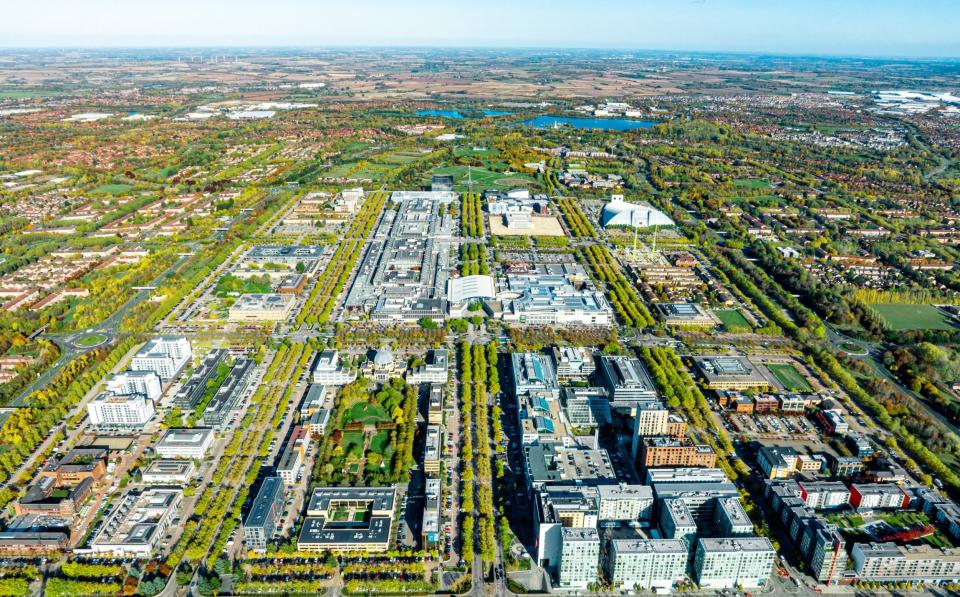‘The easy fruit has been picked’: Why Labour’s new towns scheme is doomed

Ask most people what they associate with Milton Keynes and they are likely to mention roundabouts, concrete cow sculptures and the fractious move of Wimbledon FC to the town in the early 2000s.
To Angela Rayner, however, Milton Keynes offers a blueprint for the future.
In a speech on Tuesday, Labour’s deputy leader laid out plans to build a new generation of Milton Keynes-style “new towns” to ease the housing crisis and boost the economy.
“Labour’s towns of the future” will feature green spaces and good transport links, and 40pc of homes will be classed as affordable, Rayner promised.
“We can turbo-charge growth to the benefit of working people across Britain,” she said.
In seeking a plan for the future, Rayner was reaching into the past. Milton Keynes was conceived by Harold Wilson’s Labour government as part of the third wave of new towns built to alleviate housing shortages in the wake of the Second World War.
Plans for a 250,000-person Buckinghamshire town, built on 8,850 hectares of farmland, were approved in 1967.
Wilson’s gamble paid off: nearly 60 years later, Milton Keynes is a thriving city. But experts warn Labour’s attempts to replicate such success today are doomed to fail.

Britain has less available land compared to the 1960s and what exists is far harder to build on.
The economy has also changed significantly – building a new town today is unlikely to attract businesses looking for factory and office space as it would have decades ago. Our post-industrial economy means people need houses in cities where the jobs are.
Labour’s affordable homes policy will also likely blow a hole in the funding model for new towns.
The party has tried to resurrect its new towns policy before, with little success. In 2009, Gordon Brown proposed building 10 “eco” towns, but the plans were met with protests and a legal challenge.
“Is it just a knee-jerk religious throwback that we’ve got to have new towns?” asks Paul Cheshire, emeritus professor at the London School of Economics and a former government adviser.
The biggest issue the deputy leader faces is the question of land: there’s not enough of it to build on.
“The easy fruit has been picked,” says Anthony Breach, associate director at the Centre for Cities. “In terms of the roadway junctions and obvious sites that you would choose for a new urban expansion that can be sprung up out of nowhere, there is not much.”
Crucially, although there is land that could theoretically house new towns, far more people are opposed to building on it than they were in previous years. People are reluctant to see major developments near their homes in case it destroys value or puts strain on local amenities.
“Houses have become more and more important assets, particularly for older people. Older people have tended to move out of London to the Home Counties and then they become Nimbys,” says Cheshire.
Planning rules have also been changed in favour of Nimbys. In 1969, the Government published The Skeffington Committee Report, introducing new recommendations to encourage public participation in local planning decisions.
“That gave a definite push in the direction of questioning professional planners and empowering the big local home voter lobby,” says Cheshire.
Scarcity creates value and speculators have piled into Britain’s land as the availability of viable building sites has dwindled.
“There is a whole market in completely invisible assets, which are not just options, but options on options,” says Cheshire. “This is one of the reasons why our system is so expensive and dysfunctional, because that itself is all a deadweight loss. It is just people creating paper assets out of potential land value capture.”
In short, acquiring land for development has become a hugely expensive legal mess. Breach says: “Our planning system is uniquely dysfunctional in the developed world.”
Labour could of course seek to take an axe to this thicket of rules and complexity in order to make it easier to build. Sir Keir Starmer has vowed to reform the system to favour “the builders not the blockers”.
However, Labour’s new town dreams would still be hamstrung by its own policy detail, argues Breach.
Rayner says that 40pc of homes built in the new towns will be “affordable”. However, such a high percentage of below market-rate homes would raise doubts about how the projects would be funded, Breach says.
New towns come with big upfront costs to build infrastructure, ranging from roads and drainage to schools and doctor’s offices. All of this is usually financed using borrowed money, secured against the proceeds from future home sales.
If a large chunk of these homes are to be sold below market price, developers will be able to borrow less. Taxpayers will either have to step in to make up the difference, or new town residents will have to put up with less infrastructure.
Regardless of all these concerns, Breach believes new towns are the wrong solution to Britain’s current housing crisis.
Milton Keynes is held up as a success story, but many other post-war new towns have faded into obsolescence.
After the 1970s, the British economy changed, beginning its shift away from industrial production and towards services. This made the country far more London-centric.
“Manufacturing jobs became less important to the national economy, so it became harder for the government to shuffle jobs and business and firms across the country,” says Breach.
New towns near the capital, such as Milton Keynes and Crawley, continued to perform well. However many in the north, such as Peterlee and Washington, began to grapple with unemployment and deprivation.
“You have to lean into the geography of the economy in Britain. You can’t create an entirely separate, isolated new town and expect that to perform well,” says Breach.
New towns work best when they relieve pressure on areas with bottlenecks in development. A much more effective way to ease the housing crisis and combat the planning system is to extend existing cities rather than build new ones.
Labour, it seems, knows it too. Sir Keir’s housing plans include a strategic review of the green belt, opening the door to building on land on the immediate outskirts of cities. This, analysts argue, is the policy that could actually radically change Britain’s housing quagmire.
However, that would ultimately mean building near London in the South East – in other words, the places with the highest property prices and the most complex claims around land value. This is easier said than done.
Meanwhile, Rayner’s chances of carpeting Britain with a new crop of Milton Keynes look remote. Breach predicts the plans “will dribble away into the sand”, just as Brown’s eco town scheme did.

 Yahoo Finance
Yahoo Finance 